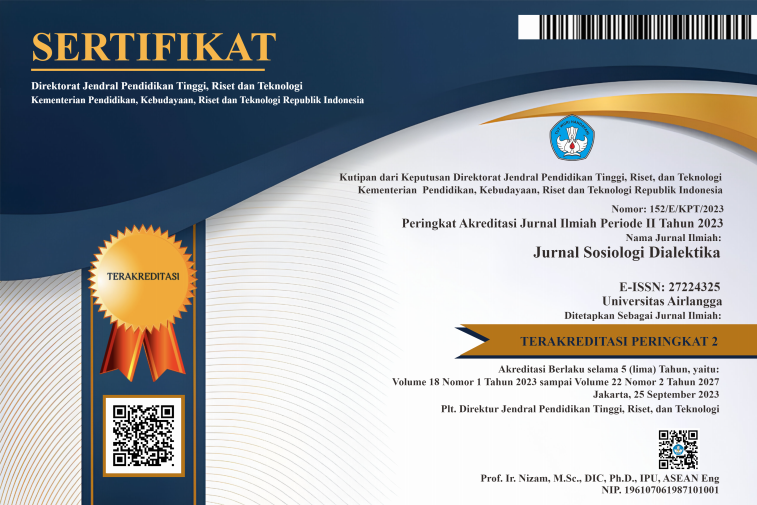Survival strategies and stigma against the poor in the 1001 Malam community in Surabaya City
Downloads
This study aimed to determine how the poor community in the 1001 Malam settlement, Surabaya, live their daily lives. Most settlers coming from villages and settling in cities (urbanization) are forced to become poor people who live under bridge tolls. Qualitative research was used to describe the lives of the settlers where the researchers interviewed 12 research subjects. This study employed the theory of symbolic interactionism proposed by George Herbert Mead, the theory of marginality proposed by Robert Park, and the theory of Stigma proposed by Erving Goffman. The results of this study indicate that settlers have a distinct sense of self and identity compared to residents of Surabaya City in general. Settlers define themselves as poor, uneducated, and without access to resources so they must work on the side to make ends meet. This study concludes that the settlers' survival strategy is to work as buskers, beggars, scavengers, hawkers, and laborers. These informal jobs make poor communities stigmatized as criminals, poor, uneducated, and slum dwellers.
Ala AB (1981) Kemiskinan dan Strategi Memerangi Kemiskinan. Yogyakarta: Liberty.
Aryani YC & Zuber A (2017) Budaya kemiskinan di Kota Surakarta (Studi etnografi di pinggir rel palang joglo, Kadipiro). Jurnal Sosiologi Dilema 32 (2).
Badan Pusat Statistik (2022) Provinsi Jawa Timur Dalam Angka 2022. Surabaya: PT. Sinar Murni Indo Printing.
Banker S, Bhanot SP, & Deshpande A (2020) Poverty identity and preference for challenge: Evidence from the US and India. Journal of Economic Psychology 76: 102214.
Barbara PB & Umilia E (2014) Clustering permukiman kumuh di kawasan pusat Kota Surabaya. Jurnal Teknik ITS 3 (2):C172-C177.
Basrowi M & Soenyono (2004) Teori sosiologi dalam tiga paradigma. Surabaya: Yayasan Kampusina.
Creswell JW (2015) Pendekatan Kualitatif, Kuantitatif, dan Mixed. Yogyakarta: Pustaka Pelajar.
Fadilla SH & Zain IM (2019) Kajian kondisi fisik, kondisi sosial dan kondisi ekonomi di permukiman kumuh Kampung 1001 Malam, Dupak, Krembangan, Kota Surabaya. Swara Bhumi e-Jurnal Pendidikan Geografi FIS Unesa 2 (1):1-7.
Goffman E (1963) Stigma: Notes on the Management of Spoiled Identity. New Jersey: Prentice-Hall.
Guillemin J (1982) Anthropological Realities: Readings in the Science of Culture. New Jersey: Transaction, Inc.
Hakim M (2019) Fatalisme dan Kemiskinan Komunitas Nelayan. Society 7 (2).
Hanani DG & Syafiq M (2013) Mengatasi ancaman identitas kemiskinan: Studi kasus sebuah keluarga miskin di Surabaya. Jurnal Penelitian Psikologi 4 (2):120-141.
Hennink M, Hutter I, & Bailey A (2020) Qualitative Research Methods. London: Sage.
Karnaji (2011) Komitmen dan konsistensi pemerintah dalam mengatasi malasah kemiskinan: Analisis kasus di Jawa Timur. Thesis, Universitas Airlangga, Surabaya.
Lan TJ (2019) Tinjauan Kritis Ketahanan Sosial (Masyarakat Miskin Perkotaan dan Perdesaan). Jakarta: LIPI Press.
Lewis O (1988) Kisah Lima Keluarga. Jakarta: Yayasan Obor Indonesia.
Liputo S (2014) Distres psikologik dan disfungsi sosial di kalangan masyarakat miskin kota malang. Psychological Journal: Science and Practice 2 (3):286-295.
Mahfudz M (2018) Konstruksi budaya mengemis pada masyarakat Desa Pragaan Daya Kecamatan Pragaan Kabupaten Sumenep Madura. Thesis, Universitas Airlangga, Surabaya.
Mead GH (1934) Mind, Self, and Society. Chicago: University of Chicago Press.
Miles MB, Huberman AM, & Saldana J (2014) Qualitative Data Analysis, A Methods Sourcebook, Edition 3. USA: Sage Publications. Terjemahan Rohidi TR. Jakarta: UI-Press.
Mulyani L & Hadi A (2014) Urban development in Indonesia: Contemporary problems and intervention programmes. A Research Report for OXFAM in Indonesia.
Noverina M (2017) Fenomena urbanisasi dan kebijakan penyediaan perumahan dan permukiman di perkotaan Indonesia. Masyarakat Indonesia 36 (2):103-124.
Prayitno US (2013) Diferensiasi peran anggota keluarga miskin perkotaan: Perspektif modal sosial. Jurnal Aspirasi 4 (1).
Santoso DD (2016) Stigmatisasi orang tua tunggal perempuan di masyarakat (Studi pada masyarakat pedukuhan dongkelan Kelurahan Panggunharjo Kecamatan Sewon Kabupaten Bantul). Thesis, Universitas Islam Negeri Sunan Kalijaga Yogyakarta, Yogyakarta.
Subagio DL & Handoyo P (2020) Fungsi sosial lansia pada keluarga miskin (Studi etnometodologi tentang pengemis lansia di Makam Sunan Giri Kabupaten Gresik). Paradigma 8 (2).
Suparlan P (1993) Kemiskinan di Perkotaan, bacaan untuk Antropologi Perkotaan. Jakarta: Yayasan Obor Indonesia.
Susanto E & Aini AN (2021) Stigma dan inklusi sosial orang miskin. Jurnal UGM: Fakultas Ilmu Sosial dan Ilmu Politik.
Suyanto B (ed) (1995) Perangkap Kemiskinan Problem & Strategis Pengentasannya. Surabaya: Airlangga University Press.
Varamitha S, Akbar SN, & Erlyani N (2016) Stigma sosial pada keluarga miskin dari pasien gangguan jiwa. Jurnal Ecopsy 1 (3).
Wahyudi SF & Pambudi H (2014) Budaya Kemiskinan Masyarakat Pemulung. Paradigma 2 (2).
Widyaningrum GL (2018) PBB: 68% populasi dunia akan tinggal di area perkotaan pada 2050. National Geographic Indonesia. National Geographic Indonesia, 18 May. [Accessed 26 October 2022]. http://nationalgeographic.grid.id/read/13673071/pbb-68-populasi-dunia-akan-tinggal-di-areaperkotaanpada-2050?page=all.
Yandri P & Juanda B (2018) Memahami karakter kemiskinan perkotaan dengan pendekatan observasional. Jurnal Ekonomi & Studi Pembangunan 19 (1):75-84.

This work is licensed under a Creative Commons Attribution-NonCommercial-ShareAlike 4.0 International License.
1. Copyright of this journal is possession of Editorial Board and Journal Manager, by the knowledge of author, whilst the moral right of the publication belongs to the author.
2. Legal formal aspect of journal publication accessibility refers to Creative Commons Attribution-NonCommercial-ShareAlike (CC BY-NC-SA), implies that publication can be used for non-commercial purposes in its original form (cannot be modified).
3. Every publications (printed/electronic) are open access for educational purposes, research, and library. Other that the aims mentioned above, editorial board is not responsible for copyright violation.















